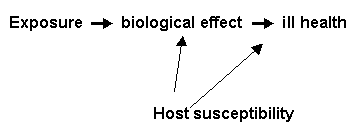 |
| Module 3: Toxicology - Section 1: Introduction to Occupational Toxicology |
| TOX 1.2: Introduction and Uses of Toxicology |
 |
| Module 3: Toxicology - Section 1: Introduction to Occupational Toxicology |
| TOX 1.2: Introduction and Uses of Toxicology |
OBJECTIVES |
|
Toxicology has been defined as: "the study of the adverse effects of chemicals on living organisms, and the assessment of the probability of their occurrence".
(See the page on Definitions in Toxicology)
The field has evolved to include adverse effects to humans and the environment. There are several sub-disciplines in toxicology and these include environmental, industrial, forensic and regulatory toxicology among others.
Toxicology has an interesting biographic history.
Toxicology as a discipline has produced a large body of knowledge much of it from laboratory, including, animal work. The detail is impossible to remember, and much of it does not have day to day application to occupational medicine. Nevertheless, a skilled occupational medicine practitioner should understand the principles of toxicology as applied to workplaces and know something about the toxicology of some important industrial substances.
For context, consider what we call the basic causal model in occupational medicine:

There must be exposure, i.e. the substance must enter the body, to produce an effect. If there is enough exposure, this may lead to ill health. This exposure effect association is modified by host susceptibility, so that only a minority of exposed workers are usually affected. See Axioms of toxicology.
Question 1: What is the meaning of the statement that you sometimes hear about asbestos that "one fibre kills"?
(Answer)
Question 2: How would you explain to managers or workers why are only some workers are affected by a given exposure and not others? Also, can these individuals be identified in advance?
(Answer)
As toxicology plays an important part in occupational risk assessment, you need to understand the four stages of epidemiologic and toxicologic risk assessment:
Our ignorance is legion. It is said that of the 65000 chemicals used in industry in the USA, human toxicity information is available on only about 1000. Less than are 100 fully characterized
Answer to Question 1: Usually applied to cancer, it has no meaning, as one would have to observe an infinitely large number of subjects to show an effect at such a low dose. It is also biologically extremely unlikely that one fibre could induce a carcinogenic response. (Back to main text.)
Answer to Question 2: Everyone has a different susceptibility to disease depending on their inborn constitution and life experience. We do not understand much about these susceptibilities and thus which individuals will get disease and who will not. (However, we can predict that a group of exposed workers will have a higher percentage of individuals with disease than a group of unexposed workers.) (Back to main text.)

Postgraduate Diploma in Occupational Health (DOH) - Modules 3: Occupational Medicine & Toxicology (Basic) by Profs Mohamed Jeebhay and Rodney Ehrlich, Health Sciences UCT is licensed under a Creative Commons Attribution-Noncommercial-Share Alike 2.5 South Africa License. Major contributors: Mohamed Jeebhay, Rodney Ehrlich, Jonny Myers, Leslie London, Sophie Kisting, Rajen Naidoo, Saloshni Naidoo. Source available from here. For any updates to the material, or more permissions beyond the scope of this license, please email healthoer@uct.ac.za or visit www.healthedu.uct.ac.za.
Last updated Jan 2007.
Disclaimer note: Some resources and descriptions may be out-dated. For suggested updates and feedback, please contact healthoer@uct.ac.za.